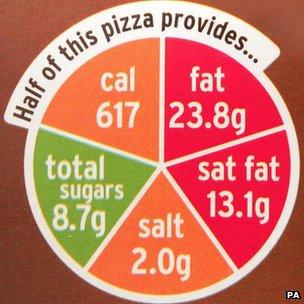Consultation launched on how to label food
- Published
- comments

The traffic light system labels less health foods red
Food manufacturers, supermarkets and health experts are to be asked their views on the best way to label the nutritional content of food.
There have been long-running battles over how to label the amount of fat, sugar, salt and calories in food - with several different systems in place.
The government's UK-wide consultation will take place over the next 12 weeks.
The health secretary, Andrew Lansley, said getting everyone to use the same system was "common sense".
He said this made it easier for people to make a healthier choice when they were buying food.
Some retailers and manufactures have preferred a "traffic light" system in which the least healthy foods are labelled red and the most healthy are in green.
Others use Guideline Daily Amounts - or GDAs - which give the percentage of recommended intake. Some use both.
'Consistent approach'
<link> <caption>European regulations</caption> <url href="http://eur-lex.europa.eu/LexUriServ/LexUriServ.do?uri=OJ:L:2011:304:0018:0063:EN:PDF" platform="highweb"/> </link> , which were agreed at the end of last year, said nutritional information must be labelled either per portion or per 100g.
Mr Lansley told the BBC it was "not possible" for him or other health ministers to "impose a solution other than the EU solution".
However, he said he was keen to work with businesses to find a "consistent" approach which could be introduced voluntarily across the UK.
He suggested that combining both the traffic light and GDA systems could help consumers.
He said he was aiming for a system which "incorporates not only what Europe requires in terms of recommended daily allowance for calories and sugar and salt and saturated fats, but in addition to that to give a means by which consumers can look at a glance, for example, using things like colour coding."
Dr Vivienne Nathanson, head of science and ethics at the British Medical Association, told the BBC: "We're great fans of traffic lights, the simpler the better."
But she said the ideal would be to have the colour coding as well as the more detailed GDAs.
Dr Nathanson said everyone using the same system would be "enormously" helpful as people were put off by "having to adjust to a different label every time you look at a different food".
Julia Waltham, from the British Heart Foundation, said: "This isn't about telling people what should or shouldn't be in their baskets.
"The government should strongly recommend that food companies and supermarkets use a consistent food labelling scheme that includes traffic light colours. They all have a responsibility to provide a system that helps shoppers compare products and then easily pick the healthiest option if they want to."
- Published7 July 2011
- Published2 February 2012